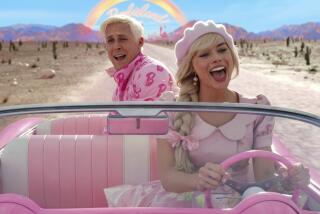A kiss is more than just a kiss
- Share via
Later this month, kisses will be exchanged on cards, in boxes of candy -- and, of course, on the lips. Scientists know how humans kiss and what happens to the body during a kiss, but why people began puckering up in the first place remains unknown.
A romantic kiss, blandly stated, involves movement of the lower jaw (the sole movable bone in the head) and contraction of 34 muscles in the face, neck and head -- principally the orbicularis orbis, which surrounds the mouth and allows the lips to pucker.
Nerve endings abundant in the lips and on the tongue rush signals to the brain, triggering a cascade of events. Blood rushes to the lips, and the body warms. Saliva pours out of glands (which is why kisses are wet), blood testosterone levels surge, and feel-good chemicals such as endorphins and oxytocin are released in the brain.
Blood pressure rises, the heart rate accelerates from around 70 to upward of 120, and calories begin to burn at a rate of around 6 a minute compared with just over 1 calorie per minute when someone’s sitting around reading or watching TV.
Kissing can be fatiguing, which is why, in the 1930s, makeup maven Max Factor decided to stop using people to test the lasting power of his lipstick. The testers kept growing tired and bored, so he replaced them with a kissing machine that pressed two rubber lips together, over and over.
Constant kissing was apparently less tedious for the couple who hold the record in the U.S. for the longest kiss -- just shy of 31 hours. The record for the so-called biggest kiss was set at a music festival in England last summer, where roughly 30,000 concertgoers smooched simultaneously.
Most of those people -- around 65% -- were probably tilting their heads to the right, according to the findings of a German researcher who came up with the figure after taking two years of notes on people kissing in public and published his results in the scientific journal Nature.
Other pollsters have determined that most people like to throw a little nibble into a bout of kissing; that New Englanders kiss on greeting far more than the rest of Americans; and that a good proportion of U.S. office workers have kissed an office mate.
Perhaps most surprising: one-quarter of American dog owners engage in pooch-smooching in public.
Researchers don’t know when or why kissing originated, but theories abound. Freud speculated (as could be expected) that kissing was a return to suckling at the breast. Some anthropologists and animal behaviorists have proposed that kissing may have evolved from sniffing, based on observations of people -- and many species of animal -- that rub noses or smell each other in greeting.
Others suspect that the pucker evolved from mouth-to-mouth feeding, sometimes called “kiss feeding.” Think of mama bird feeding her nest of baby birds -- and imagine that our distant evolutionary ancestors did something similar. Then imagine that, over time, our hominid ancestors lost the need to join lips for feeding but kept joining lips for fun.
One hundred years ago, anthropologists were fairly certain that people in Madagascar and many parts of Polynesia and Africa, as well as Finnish tribes and the people of Tierra del Fuego, didn’t kiss. But scholars now acknowledge that most humans do.
Contributing to that early confusion was the wide variety in what constitutes a kiss. Visiting the Trobriand Islands (now the Kiriwina Islands) off the coast of New Guinea in the 1920s, one anthropologist learned that a kiss there consisted of nose- and cheek-rubbing; vigorous lip-sucking; lip-, chin-, cheek- and nose-biting; hair-pulling and eyelash-biting.
Even if kissing doesn’t prove hazardous to the chin, cheeks and nose, it can prove risky in other ways. Millions of bacteria pass between the mouths of two kissing lovers. Most are benign, but kissing is a good way to pick up a cold, the flu -- or a morsel of the egg salad or peanut butter your beau had for lunch, a nontrivial matter for someone with serious allergies.
The fact that a kiss so efficiently transfers the contents of one mouth to another perhaps explains a bit of ancient Egyptian etymology. In the time of the pharaohs, Egyptians, curiously enough, referred to eating as kissing one’s food.
Perhaps they knew more about the origins of kissing than we do today.
--






